I helped make the first Miata, and now I love its ancestor
I had never owned a car like this, one with pre-war roots, and I wasn’t looking for it. But if you’re bored and hunting on Craigslist long enough, you usually run across something that catches your eye. Something you probably shouldn’t buy.
That’s how I met Abigail.
Abigail is a 1952 MG TD. The TD is part of MG’s “T-Series” family, five models produced, one after the other, from 1936 to 1955. The TA came first, then the TB, the TC, the TD, and the TF. Each is a variation on the same basic idea. They all have long and flowing fenders, a long-stroke four-cylinder, a four-speed gearbox, and an ash-framed body. The TC, TD, and TF were built after World War II, but like so many cars of the era, their engineering basically dated to the 1930s.

The 54-hp TD met the world in 1949. It was really just a restyle and a light mechanical update of the TC. Both cars were relatively affordable and handled well. On the Miata project (See postscript: The author was a development engineer on the original Mazda Miata —Ed.) we had cited the T-Series as helping start this country’s sports-car craze, so I had a vague interest in owning one. Having just sold Edna, my ’64 Chrysler Imperial—the widest, largest, and most powerful American car made in its model year—it felt somehow right to be entranced by a diminutive lightweight like the TD.
The ad called the car an “older restoration,” noting that the owner needed to move it along to fund other projects. The following weekend, I visited the owner at his small farm near North Carolina’s coast and was smitten by the TD’s tomboy charm. It was essentially an upright piano on skinny tires.

We rolled the MG out into the sunshine. The owner started it with a simple pull of the starter knob. The engine sounded like a sewing machine. The car was indeed an excellent example, having received a frame-off restoration about eight years prior. The TD appeared to have been reassembled in the aisle of the Moss Motors warehouse—every rubber part was new, along with all the gaskets and trim. The metal bits had just enough patina to make the car look real to me.
In whole, it looked about like a 40,000-mile TD from, say, 1958. Not showroom-new, but not tattered, either—just the way I like my cars. The owner let the TD idle in the summer sun, no concern for overheating. I was impressed. Watching an English car idle for 30 minutes in 95-degree weather is like seeing a 90-year-old man do 100 push ups.
We struck a deal. I made plans to return the next weekend with either a trailer or a tow truck. On the 200-mile drive home, I texted a friend—let’s call him Q. He was a fellow Brit-sports-car aficionado. (Translation: patient with flaws, curious and willing to learn, steadfast in times of trouble. Good qualities in a car person or a friend).
Q said that he could help me pick up the MG with his trailer. But he’d only agree to help, he said, if we drove the TD back home.
“This car has not been on the road in eight years,” I said.
“Don’t wuss out,” he retorted. “What could go possibly wrong?”
And so the plan was made to drive together to get the car, then drive back in tandem, bracing for the possibilities that lay buried deep inside every one of that 70-year-old TD’s 1500-some-odd parts. The chase vehicle would be my 30-year-old Miata.
Yes, this is what counts as adventure in our man-bunned, flip-flop-wearing world: a three-hour drive on a paved road, in two cars, with no lions, tigers, or even bears.
At home, I made up a spares package. If you bring the tool/part/item, I figured, you probably won’t need it. A spare car battery fully charged: onboard. Gorilla tape and a small butane torch, plus some 12-gauge wire and solder: of course. Fix-a-flat and a jack: check. Carb cleaner and a length of fuel line: yep. We planned a route that avoided highways, sticking to interesting two-lanes with pull-off room and low traffic. (This was not our first British-sports-car rodeo.) I joined the Hagerty Driver’s Club and elected for the 150-mile towing option, then drew a circle of that radius around my home, which I called the “circle of safety.” Like an RAF pilot trying to get back across the English Channel, I knew that if I could just get the TD inside that radius—see the white cliffs of Dover—all would be well.
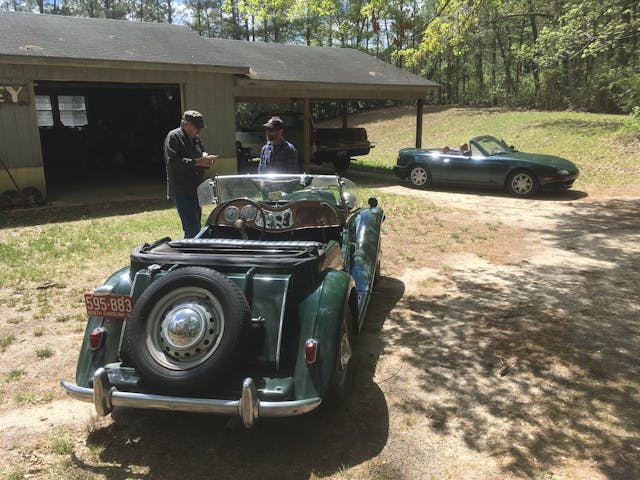
The following Saturday, we left to get the car. The trip there was uneventful, as most Miata trips are. When we arrived at the barn, the owner had the TD out in the sun and ready to go.
He looked around for a trailer, then back at us. “You’re going to drive this to Charlotte?”
“Any reason we shouldn’t?”
The man looked into my eyes for a double-count, the cash I had given him still palmed in his right hand. “Keep an eye on the fuel tank,” he said. “She clogs up now and then . . . ”

With that, we were off. It was noon. Plenty of margin for a three-hour drive on a lovely Saturday afternoon. I let Q drive first. First, I wanted to watch for any unusual behavior as the MG went down the road. Second, as a practical matter—I wanted to be able to see (and then collect) any parts that might fall off as Q got up to speed.
Speed being a relative term, of course, with a TD. When the car was new, it had a top-top-top speed of 74 mph. That number came in fourth gear, at the dizzying engine speed of 5500 rpm (a.k.a. the precipice of valve float).
The third reason I wanted to follow the car on that first leg? I am a visual person. Watching the MG bumble across eastern North Carolina was going to be fun.
That three-hour estimate would prove optimistic. At first, everything seemed fine. Ten minutes in, however, the car began to lose speed. Q raised his left arm and signaled—TDs don’t have visible turn signals—to pull off into a parking lot. The words of Road & Track’s Peter Egan arose from deep in my consciousness: It’s always the points.
I prepared myself for a little roadside diagnostics. This would be the first stop of more than a dozen. Over the next seven, not three, hours.

Pulling the distributor cap and rocking the car around in gear showed that, indeed, the gap on the MG’s ignition points was too small. Q assumed the kneeling position beside the engine, a posture familiar to T-Series owners (and to owners of early Porsche 911s—it’s a position of petition and humility, as if praying to the electrical gods). He made a quick adjustment and then we were off again, confident in our roadside tune-up.
Ten miles later, Q’s left hand waved once again. One more time, we pulled over to inspect the points. They were out of adjustment again, so we realigned them once more. We were only 10 miles closer to my circle of safety, and progress was agonizingly slow.
Ten more miles. Left hand up again. The points gap was now somehow too small. While messing around with the distributor, we realized the distributor had roughly half an inch of play, left to right, from a perished bushing. You could vary the points gap simply by pushing on the distributor’s body. On a subsequent stop, we took some zip ties and some spare fuel hose and used them to jam the distributor against a nearby object—in this case, the engine’s generator—forcing it into something like one position.
Setting off, we were emboldened, confident.
Ten minutes later, we were once again in a parking lot, once again looking at the distributor. The point gap was holding at an acceptable level. Emboldened by our diagnostic prowess, we quickly condemned the ignition condenser, a part that can cause intermittent poor running. There was a new one in a box of spares that came with the car. On it went. Back on the road we went.
At this point, I took over driving, having seen my fill of the TD’s rear and Q’s insistent hand signaling. We were about 20 miles to the edge of our tow range, and I was determined to make it. I was instantly reminded of how special old British sports cars are: tight steering, excellent shifters and transmissions, responsive brakes. I ran through my list of known English-girl names and settled on Abigail. The only real hiccup was a severe shimmy at speed, which I chalked up to flat-spotted tires. The whole chassis shook up and down, side-to-side, and in the yaw axis, all at once.
No matter—two miles later, the car was coughing and sputtering again. I pulled into the parking lot of an auto-parts store, ready to buy anything.
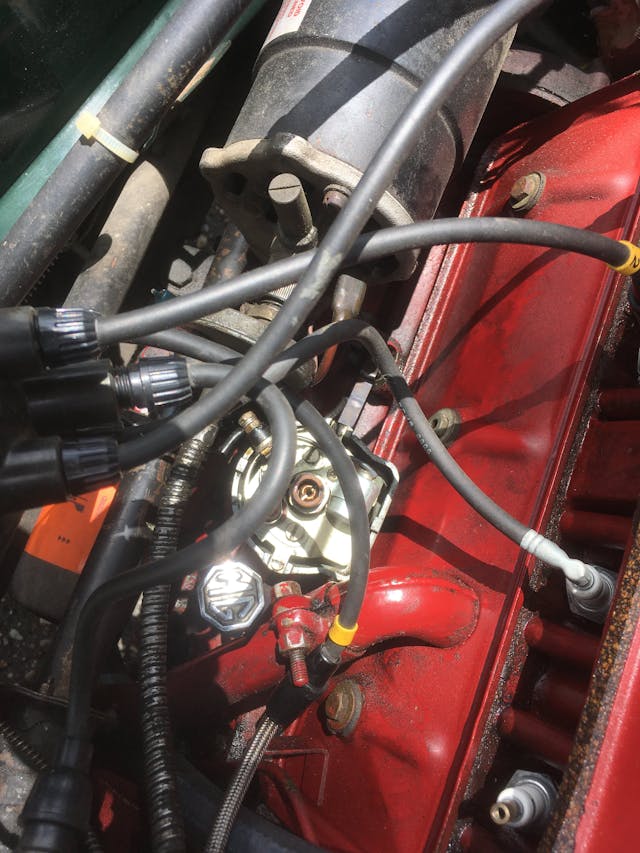
The seller’s parting words came back to me: She clogs up now and then.
I lay on the ground to inspect the fuel lines. A T-Series carries its fuel like a backpack, in a wedge-shaped slab tank just behind the body. When I opened one of the barbed fuel fittings beneath the tank, nothing came out. The barb’s innards were caked with flakes of rust.
Ah, I thought: It had never been the ignition! Our short stops to adjust the points had given the fuel system enough time to weep a few ounces of gas into the line, letting the engine restart. After which it would inevitably stall again, once fuel stopped flowing. A simple probe with a small stick cleared the line and got fuel gushing from the nipple. Once the gasoline ran clear, I put the hose back in place and moved to the front of the car, to the feed line at the carburetors. Fuel ran clear there pretty quickly, and then we were back on the road.
Well, almost. Along the way, the battery had grown too weak to turn the engine over, so we had to push-start the car.
I was reminded, once again, of the advantages of a lightweight sports car: You can push-start them when needed.
I sprinted out of the parking lot with bouts of full-throttle TD acceleration (a.k.a. barely keeping up with traffic). All was again great with the world. For 20 miles. Then my hand went up, and I repeated the fuel-purge routine. Nine more times, we performed this choreography, before reaching home, once every 15 miles or so. Toward the end, we got it down to a 90-second pit stop for both tank drain and carb-line purge.
We were well inside the towable radius now, but we felt we had licked the symptoms, if not the disease. Getting Abigail home under her own power had become a challenge. (On one of the purge routines, I noticed that the left rear brake cylinder was leaking. Something to address later—we were having trouble with propulsion, not stopping.)
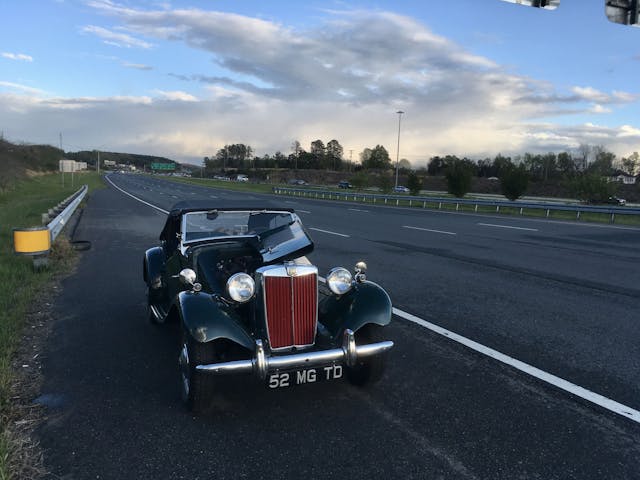
In between these regular purge routines, I took inventory. The engine really didn’t mind going 5000 rpm at 65 mph. The steering was precise, the ride comfortable. A T-Series steering wheel is the size of an extra-large pizza and perfectly complements the wooden dash. The whole package worked well, and the attraction was undeniable. As a bonus, it was one of those cars so lovely to look at that you almost don’t mind taking in that beauty while sitting on the side of the road, wondering why the thing won’t run.
A few miles down the road, I looked in the mirror to see Q signaling from the Miata. I dove into a church’s parking lot, curious as to what could possibly could be wrong with our Japanese car. Q pulled up alongside.
“My phone’s weather app says we are driving into a rainstorm.” Then, in one of those I only have to run faster than the bear moments, he flipped up the Miata’s top with one hand and drove off.
I waved him back. We spent 10 minutes unfolding and erecting the MG’s prehistoric top. The car came from the factory with side curtains—clip-on fabric windows—but we didn’t have them. The TD’s roof amounted to a little more than a lousy umbrella, but it was better than no top at all. With that, we were off, into dark clouds ahead.
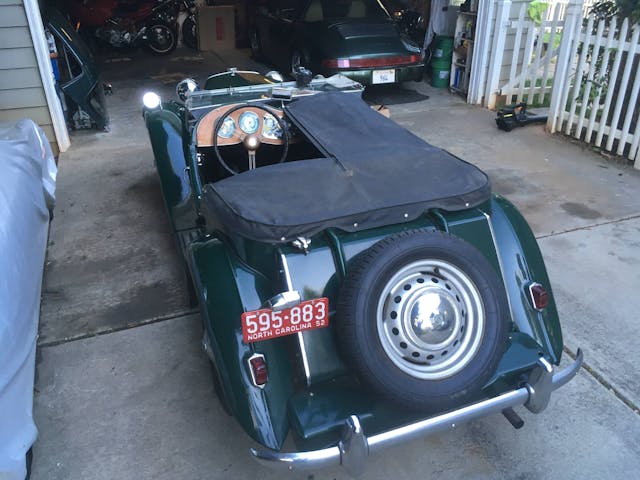
And rain it did. So on we drove, one-handed, with Q in the serene comfort of a watertight Mazda and me in what was essentially a wooden sailboat caught in a squall. Two more fuel-line purges were required to get through the storm, and we reached the outskirts of Charlotte with a sigh of relief.
The rain stopped, the sun came out, and the TD, somehow, settled down into a happy zone of peace and harmony. The shimmies from the flat-spotted tires finally worked themselves out. I became comfortable with a 5000-rpm cruise. The car ran wonderfully, and we came to terms with each other. The fuel tank pulled one last clogging routine, but we made it the last 10 miles to my house without incident, arriving just as the sun was setting. I pulled into my driveway and let Abigail idle for a moment, rechecking her gauges and thanking her for making it all the way home without a tow.

We had accomplished something together, she and I, and it felt good. I switched off the ignition and listened to the engine tick and gurgle as it cooled. Abigail deposited a cup of engine oil on the driveway, as if to mark her spot. Seven hours of noise melted into a nice moment of joy.

Life with Abigail is now bliss. She is a joy to drive, now that I’ve over-engineered her fuel system and fixed that leaky wheel cylinder. And people in town love her. Everyone waves and smiles when they see her coming. There is something endearing about a ridiculous car and the fool who loves her, as if we were made for each other.
Check out the Hagerty Media homepage so you don’t miss a single story, or better yet, bookmark it.
***
Norman Garrett was the Concept Engineer for the original Miata back in his days at Mazda’s Southern California Design Studio. When he’s not curating his small collection of dysfunctional automobiles and motorcycles, he teaches automotive engineering classes at UNC Charlotte’s Motorsports Engineering Department, in Charlotte, North Carolina.
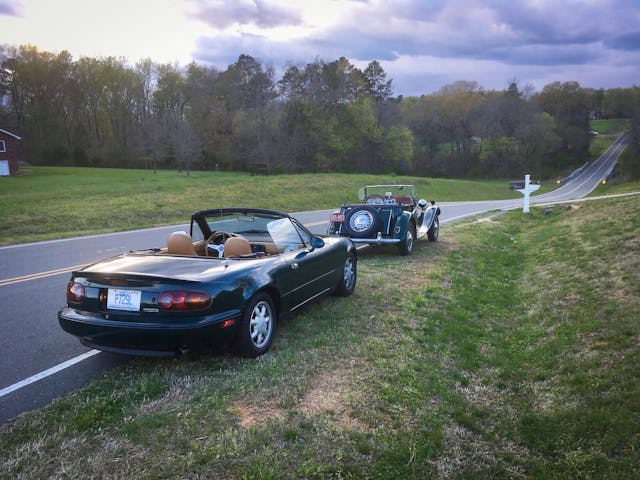

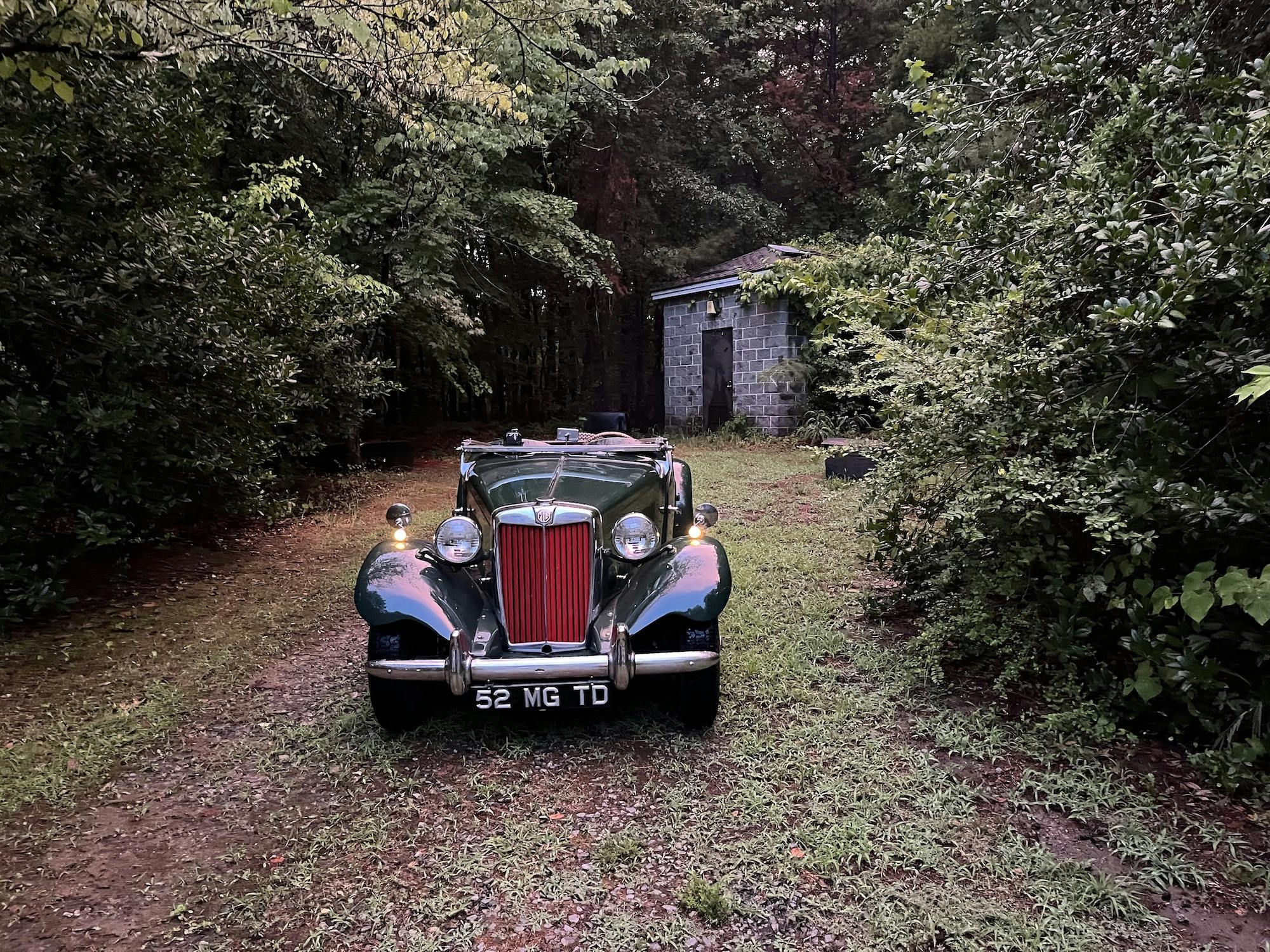
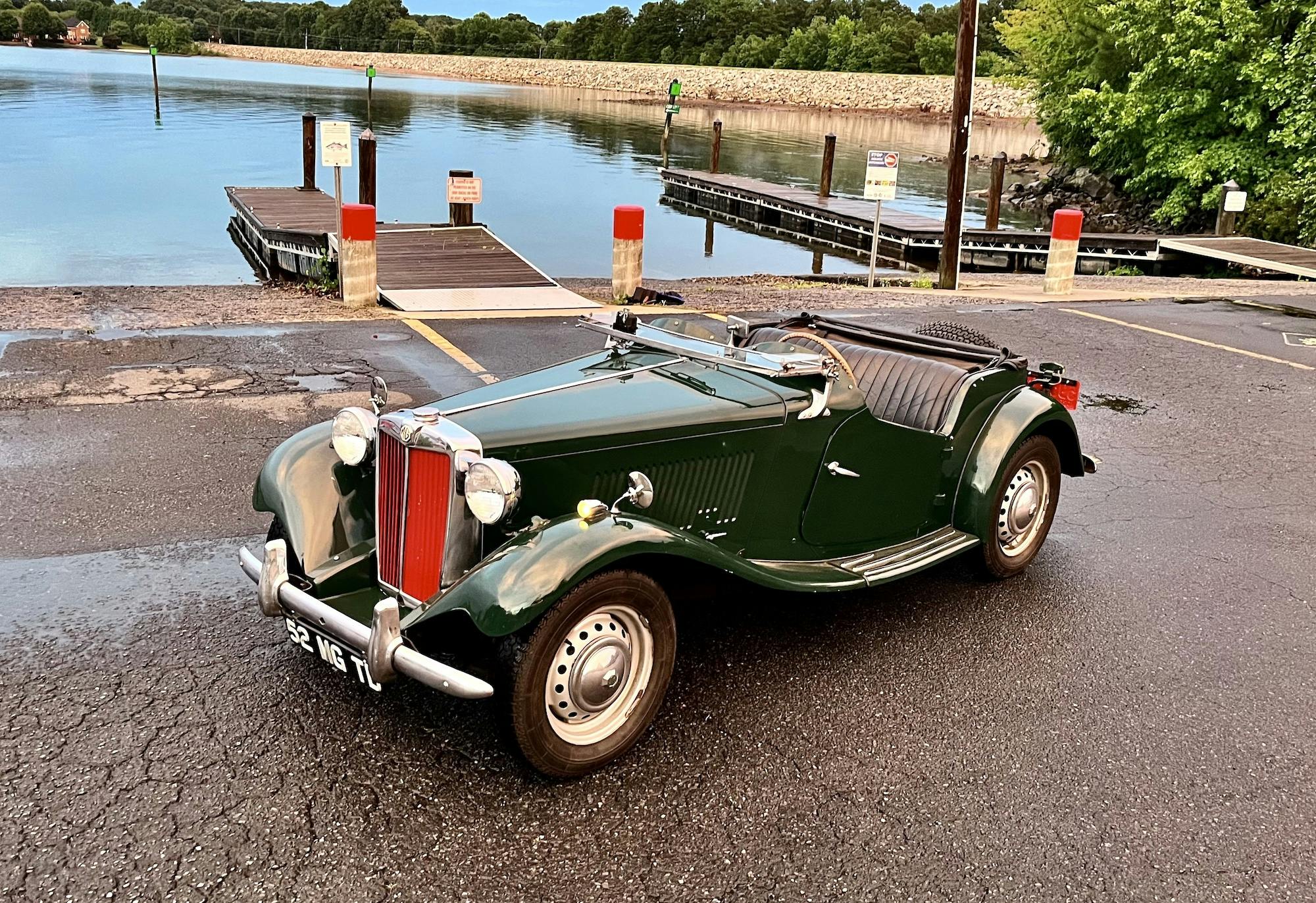
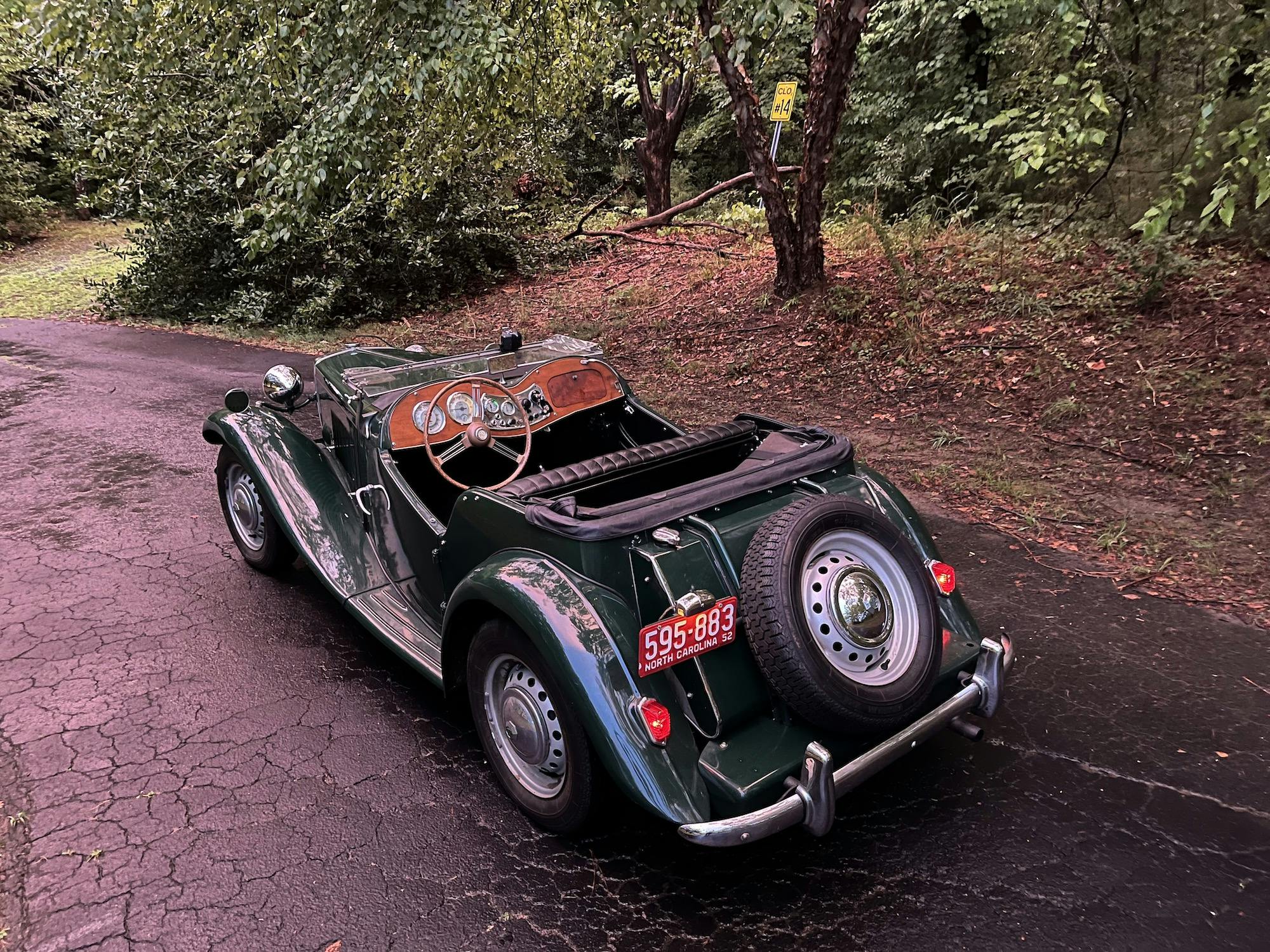

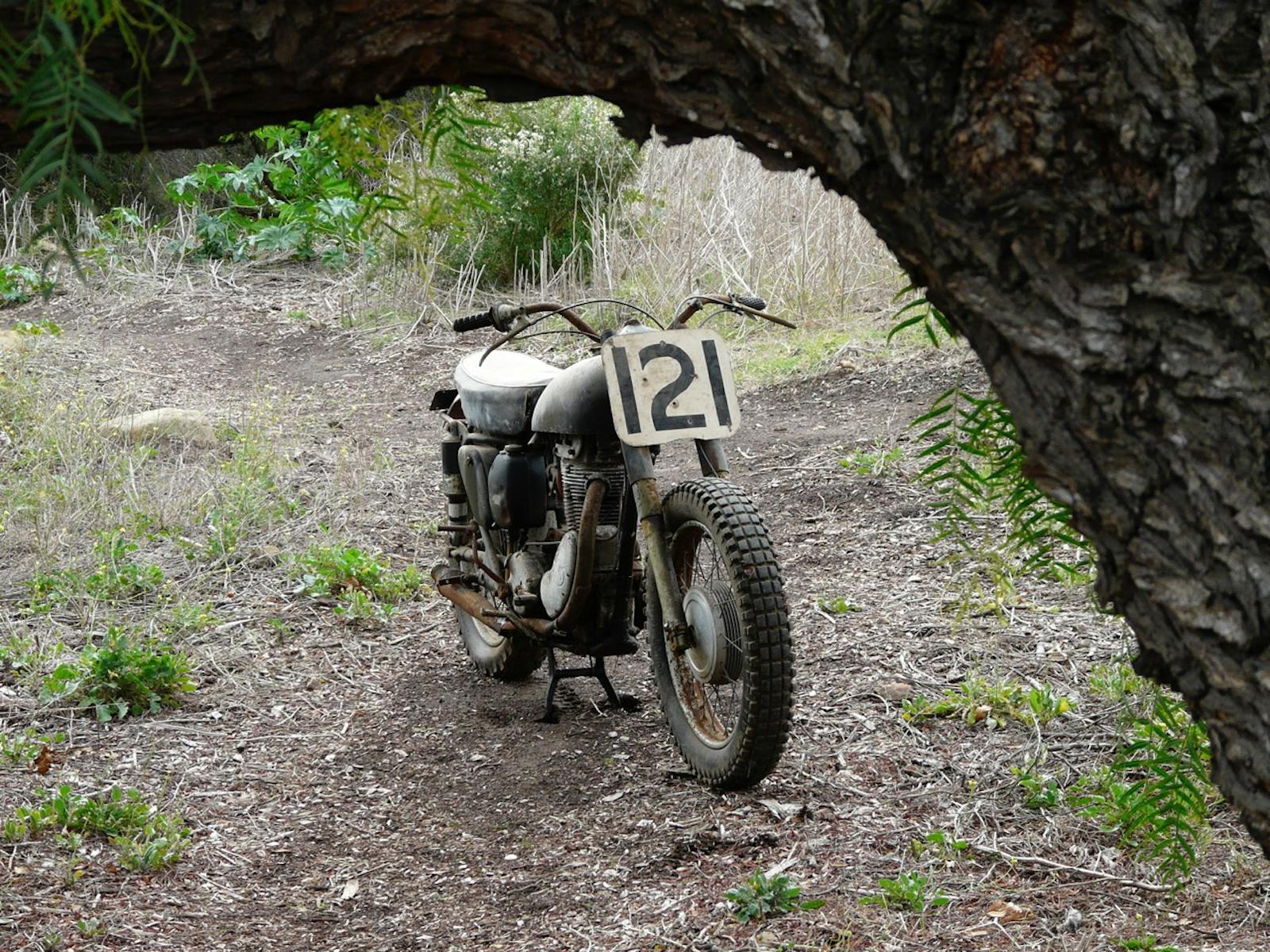

Great story. I really enjoyed this one.
What a fun story, and what a particularly tasty 964 Targa. I’m a big NA fan, and am lucky enough to have talked to Tom and Bob et al (fun fact, Bob knows far too much about weird Canadian-market domestic cars). At the NA restoration line in Hiroshima, at least one of the technicians is former 787B Le Mans pit crew.
I hope you will regale us with the story behind that crumpled 911 hood one of these days…
Well told. You’ve stirred up some memories, here. We had a very similar adventure in 1984, with spares, ingenuity and (mostly) luck, driving a Datsun 2000 home from Pennsylvania.
Love, love, love the pic of the dog! That is one content boy (or girl).
I really enjoyed hearing about your purchase and trip. I have a TD in pieces. One note is that the TD is mechanically different from the TC due to its independent front suspension and rack and pinion steering.
My TD was my fifth M.G., and I drove to pick it up in my ’96 Miata. My wife drove the Miata home and I took the TD — a sunny day, only about 30 miles from home.
Five miles from the seller’s house, the TD ran very rough and then not at all. My previous four M.G.s (and a few other ancient vehicles) taught me the same lesson you recalled: it’s (nearly) always the ignition. So I popped the piano-hinged bonnet cover on the left side and felt like the luckiest kid in town:
The #1 plug wire was loose, lying on the generator. I picked it up, figuring I could just snap it back onto the plug, and discovered that the ceramic insulator was still IN the plug wire — the rest of the plug was in the cylinder head.
I had a plug wrench and even brought a few spare/used plugs just in case, but when I got the plug out of the TD’s cylinder head, the length of threads was MUCH shorter on the TD plug. As I was wondering what to do, my wife walked up after rummaging through the box of spares that the seller had put in the Miata’s trunk.
“Would this help?”
She held up a grimy but intact TD spark plug.
It would indeed help. I eyeballed the gap and pronounced it good, then threaded it into the head. The TD started on the first pull of the starter knob and I motored home, enjoying a magnificent early-summer day in the Oregon Wine Country.
I owned the TD for six or seven years, showed it in a few local concours in preservation class, as it still wore its original Almond Green paint and factory leather, and eventually sold it — to fund the purchase of my current (and third) Miata.
I do have a photo of that first Miata and the TD parked on the street near my house. I’ve always thought the title of that picture should have been “Two answers to the same question, 45 years apart.” The question obviously being, what’s the most fun one or at most two people can have for the least amount of money?
Seems I’ve heard this before. 🙂
Torn between two loves. Classic British Sports cars, which for whatever reason I love or fun reliable 1999
Miata which my partner and I have owned for five years and enjoy driving here on Vancouver Island.
Since I have the mechanical aptitude of a soap dish I am afraid I will never own a British sportscar………..well maybe a Morgan.
British cars are always an adventure, fun and well worth having.Does anyone know the real reason for the knockoff hammer? Think tapping the stuck bendix on the open nose starter.
Wheels
Great story. My 1951 TD, Rose, is also an older restoration. Restored in the early eighties it spent 30 years in an Arizona art Gallery as a “sculpture” It was made road worthy, auctioned, purchased and now roams around coastal SE NC.
Nice story. My ’51 TD and my ’91 Miata SE share my garage with my ’37 Buick Special. I especially enjoy driving the TD up the curvy Rock Mountain foothills canyons west of Denver.
’52 pre war ?
Depends on which war to which you refer.
Great article, but yeah, I was wondering which war they were talking about too. WWII was over in 1945. Korean war was still going on in 1952, so pre-Vietnam war maybe? Hmm.
Unfortunately, every car ever produced is “Pre-War”.
Prewar engineering, postwar manufacture
Swell tale, thanks, Norm and Hagerty. And Craig above, you’ve got a nice trio yourself.
Great memories of traveling my ’62 TR3-A from Northern Wisconsin to Madison. Surprise. Early Fall snowstorm. No top. Just the tonneau and Winter jacket! Luckily…..only needed gas at the Stevens Point pit stop!
I fell in love with the MG because the college bookstore manager who I had an unspoken crush on and also had my last name (no relative) owned one. I never got one, but did own several Spitfires, a couple larger Triumphs and a bug eye Sprite. I enjoyed them all but memories of my unrequited lust for the MG (and its owner) of my college days still elicits desire. I am 85 now so memories likely will have to suffice.
Classic line…”it was one of those cars so lovely to look at that you almost don’t mind taking in that beauty while sitting on the side of the road, wondering why the thing won’t run.”
Thank you for that article. It finally put a lid on my wish to own a TD. I do not have the skills or patience to deal with it. I am 75 and lusted for a TD ever since I first saw one (age 2?). I DO have a lot of fun with my Mini Cooper,
I even checked into the TD kit cars made in Brazil once. But they are just not the same as the original.
While I really enjoyed the story, when I read the title I thought it would be about a Lotus Elan. From the dash board, the value cover, and the Minilight inspired wheels, the Miata was a wonderful knock-off of the Elan
Agreed. A Miata is an appliance. The Elan is a sports car, as is any MG like this one.. When I decided to move on from Elan ownership I bought a Europa. I enjoy a challenge. And Mazda haven’t copied it yet. 😉